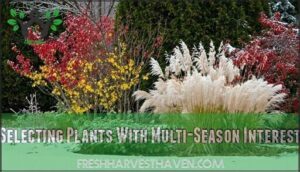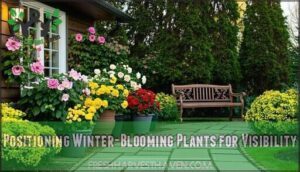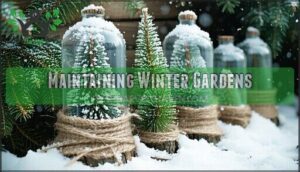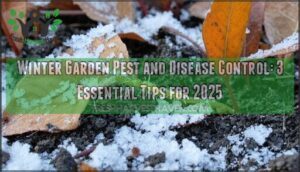This site is supported by our readers. We may earn a commission, at no cost to you, if you purchase through links.
 You’ll need strategic winter garden cover ideas to protect your plants while maintaining visual appeal. Start with burlap wraps for delicate shrubs and frost blankets for tender perennials—they’re your first line of defense against harsh weather. Evergreen boughs create natural mulch that insulates roots while looking gorgeous.
You’ll need strategic winter garden cover ideas to protect your plants while maintaining visual appeal. Start with burlap wraps for delicate shrubs and frost blankets for tender perennials—they’re your first line of defense against harsh weather. Evergreen boughs create natural mulch that insulates roots while looking gorgeous.
Cold frames extend your growing season for winter vegetables, while decorative plant covers double as garden art. Don’t forget mulch layers using fallen leaves—they’re free insulation that breaks down into rich compost.
Smart gardeners also use container groupings to create warm microclimates and relocate tender plants to protected spots. The best covers combine function with beauty, turning winter protection into an opportunity for creative garden design that keeps your plants thriving through the coldest months.
Table Of Contents
- Key Takeaways
- Winter Garden Planning
- Plant Selection Strategies
- Winter Garden Design
- Maintaining Winter Gardens
- Supporting Wildlife in Winter
- Practical Winter Gardening Techniques
- Enhancing Winter Garden Aesthetics
- Frequently Asked Questions (FAQs)
- How do I protect my garden from winter weather?
- What are the best Winter Garden ideas?
- Do you need a ground cover in winter?
- How do you cover a vegetable garden in winter?
- What makes a beautiful winter garden?
- Are Winter Garden ideas a good idea?
- How do I protect my garden during winter?
- What can you put in a Winter Garden?
- What is the best winter cover for a garden?
- What is the best way to cover your garden for winter?
- Conclusion
Key Takeaways
- You’ll need multiple protection strategies – combine burlap wraps for shrubs, frost blankets for perennials, and evergreen boughs for natural mulch to create comprehensive winter plant protection.
- Smart covers double as garden art – decorative cold frames, attractive plant wraps, and strategic container groupings create warm microclimates while maintaining visual appeal throughout winter.
- Free materials work best – fallen leaves provide excellent insulation and break down into compost, while natural mulch layers protect roots without costing extra money.
- Proper planning prevents plant loss – gardens with winter protection see 40% higher survival rates, so you’ll want to relocate tender plants and establish protective structures before harsh weather hits.
Winter Garden Planning
Planning your winter garden isn’t just about surviving cold weather—it’s your chance to create a thriving outdoor space that looks great all season long.
You’ll need to make smart choices about which plants to keep outside, what to move indoors, and how to protect everything from harsh winter conditions.
Choosing Plants for Winter Survival
Start your plant selection journey by understanding your Hardiness Zones—they’ll guide every winter protection decision you make. Evergreen shrubs provide reliable structure while cold-hardy natives usually outperform exotic varieties in harsh conditions.
Consider these winning combinations for your winter protection strategy:
- Winter Blooms from hellebores paired with Berry Interest from winterberry holly
- Fragrant Appeal from witch hazel combined with sturdy Evergreen Structure
- Native grasses offering movement alongside reliable conifers for backdrop stability
Smart plant selection means choosing varieties that’ll thrive rather than merely survive your local climate challenges.
Preparing Containers for Outdoor Overwintering
Successfully overwintering potted plants requires strategic preparation that transforms vulnerable containers into frost-resistant havens. Choose double-walled plastic or fiberglass containers that won’t crack under freeze-thaw cycles.
Transform vulnerable containers into frost-resistant havens with smart winter prep
Your winter container care essentials:
- Container Insulation – Wrap pots in bubble wrap or burlap for added warmth
- Drainage Solutions – Remove saucers and guarantee proper water flow
- Location Selection – Group containers near south-facing walls for protection
Use quality potting mix rather than garden soil to prevent waterlogging. To further protect plants, consider using frost blankets when freezing temperatures are anticipated. Add organic mulch around rims for frost protection while maintaining plant hardiness through proper winter garden covers.
Moving Tropicals and Tender Annuals Indoors
After preparing your containers, you’ll need to relocate your tropicals and tender annuals to warmer indoor spots. Begin Indoor Acclimation two weeks before the first frost by gradually reducing outdoor exposure time each day. This helps prevent shock and guarantees successful Winter Garden Care.
Inspect every plant for pests before bringing them inside—Pest Prevention saves you headaches later. Match their Light Requirements to what they enjoyed outdoors, and adjust Humidity Control with water trays or humidifiers.
Your Potted Plants will thank you for this careful Winterizing Your Garden approach.
Relocating Tender Perennials to Unheated Spaces
You’ll find tender perennials like dahlias and cannas need different dormancy requirements than their tropical cousins. These container plants thrive in unheated spaces where temperatures stay between 32-45°F, making garages, basements, and cold frames perfect winter homes for your potted plants.
Space considerations for tender plants:
- Monitor storage areas with digital thermometers for consistent temperature control
- Verify proper ventilation to prevent fungal issues in your winter container care routine
- Check watering frequency every 2-3 weeks, keeping soil barely moist to prevent rot
Light needs remain minimal during dormancy, though complete darkness helps prevent premature sprouting. Your plant protection methods should focus on pest prevention through regular inspection.
Plant Selection Strategies
You’ll want to choose plants that deliver impact across multiple seasons, not just survive winter’s harsh conditions. Smart plant selection means prioritizing varieties that offer winter blooms, attractive bark, fragrant flowers, or colorful berries to keep your garden interesting year-round.
Selecting Plants With Multi-Season Interest
Smart plant selection creates year-round appeal that transforms your winter garden design. Choose specimens offering seasonal qualities like Red Twig Dogwood’s colorful bark interest or ornamental grasses providing movement and unique shapes.
Witch Hazel delivers fragrant blooms when everything sleeps. Evergreen plants with berries extend winter interest beyond basic protection, creating textural contrast that’ll make neighbors curious about your gardening secrets.
Choosing Winter-Blooming Plants for Color
Transform your winter garden into a vibrant Winter Color Palette by choosing plants that bloom through cold months. Camellias deliver bold reds while hellebores offer gentle pastels, creating stunning winter color combinations.
Strategic Bloom Time Variety guarantees continuous displays—snowdrops emerge first, followed by crocus for extended winter interest.
- Fragrant Winter Blooms like witch hazel perfume your garden walks
- Bold camellia colors create dramatic focal points against snow
- Delicate cyclamen adds charm to shaded winter garden areas
- Cheerful winter jasmine brightens the dreariest January days
Incorporating Fragrant Plants for Sensory Appeal
Winter fragrance transforms your garden into a sensory sanctuary when icy winds carry aromatic choices through crisp air. You’ll want fragrant placement near pathways and windows where scents can drift indoors, creating intimate moments with nature’s winter perfumes. These aromatic selections provide natural winter plant protection by attracting beneficial insects even during cold months.
- Winter Daphne – delivers intense vanilla sweetness that carries farther in cold, dense air
- Witch Hazel varieties – release spicy, citrus notes when branches appear bare and lifeless
- Winter Honeysuckle – produces lemony bursts from December through February’s harsh weather
- Sweetbox (Sarcococca) – offers honey-like fragrance perfect for doorway winter garden cover ideas
Adding Plants With Berries for Wildlife Support
Nothing beats berry-producing plants when you’re creating winter garden cover ideas that double as a wildlife food source. These colorful champions provide essential winter bird support while adding stunning berry color impact to your landscape. Your berry plant selection should include native berry varieties like winterberry holly’s bright red clusters and viburnum’s blue-black gems.
These winter berries transform your garden into nature’s buffet, supporting winter wildlife while providing natural winter garden protection through their dense growth patterns.
Winter Garden Design
Your winter garden design determines how well your plants survive harsh conditions and how beautiful your space looks during the coldest months. Smart positioning of evergreens, strategic placement of winter bloomers, and thoughtful use of structural elements create both protection and visual appeal when other gardens look bare.
Creating Structure With Evergreens and Deciduous Trees
Your garden’s foundation rests on strategic placement of evergreen plants and deciduous trees that create year-round visual interest. These structural elements become your winter garden’s architectural heroes when flowers fade.
Here’s how to build stunning Winter Silhouettes and Spatial Definition:
- Position towering evergreen shrubs as anchor points that define garden rooms and provide Evergreen Textures against stark winter skies
- Showcase bare Deciduous Shapes like Japanese maples whose Branching Patterns create intricate shadows on snow-covered ground
- Layer different evergreen plants from dwarf conifers to tall spruces, creating depth and winter protection for tender plants behind them
- Wrap sensitive specimens in burlap while maintaining the structural beauty of your winter garden cover ideas
Smart placement transforms ordinary yards into winter wonderlands.
Using Multi-Trunked Trees and Bare Branching Forms
Bare branches become winter’s showstoppers when you choose the right skeletal trees for your space. Multi-trunked specimens create dramatic Visual Texture through their intricate Branching Patterns, turning your winter garden into a living sculpture gallery. These Winter Silhouettes provide Structural Interest that anchors your design when colorful blooms fade.
Consider also planning for spring by reviewing seed catalogs to get a head start. This Bare Beauty transforms your winter garden design into year-round art, proving that sometimes less really is more.
Positioning Winter-Blooming Plants for Visibility
Set up your winter-blooming plants where you’ll catch their beauty every day. Strategic positioning transforms ordinary garden strolls into colorful discoveries that brighten dark winter months.
Sunlight exposure and background contrast create stunning focal points that draw attention naturally. Consider microclimate considerations and viewing angles when planning your winter garden design.
- Position hellebores near kitchen windows for daily morning glimpses
- Plant camellias against dark evergreen backdrops for dramatic contrast
- Line walkways with winter jasmine containers for fragrant surprises
- Place cyclamen clusters where porch lights highlight evening blooms
- Arrange witch hazel near seating areas to enjoy their spicy scent
Grouping Winter-Blooming Plants for Vibrant Displays
Creating color harmony through strategic grouping transforms your winter landscape into a showstopper. Position three to five winterblooming plants together, mixing different heights and textures for stunning winter garden aesthetics.
Consider bloom succession timing and sunlight needs when planning your plant selection. Height variation and texture contrast add visual depth, while smart winter garden design ideas guarantee your displays shine against snowy backdrops.
Maintaining Winter Gardens
Winter maintenance keeps your garden healthy and thriving through the coldest months. You’ll need to balance protecting vulnerable plants while preserving the natural beauty that makes winter gardens special.
Pruning Dormant Shrubs and Trees
Take advantage of winter’s quiet season when dormant trees reveal their true structure without leafy distractions. Pruning Timing becomes vital during this window—late fall through early spring offers the best results for most deciduous plants. You’ll avoid stressing trees during active growth periods while preventing disease transmission that’s common during warmer months.
Tool Selection matters more than you might think. Sharp, clean equipment prevents ragged cuts that invite problems.
Here’s your winter pruning action plan:
- Focus on structural improvements – Remove crossing branches, dead wood, and poorly positioned limbs that compromise the tree’s framework
- Perfect your Shaping Techniques** – Thin crowded areas to improve air circulation and light penetration throughout the canopy
- Practice proper Disease Prevention** – Sterilize tools between cuts, especially when working with different plants or removing diseased material
- Apply Wound Treatment** carefully – Large cuts benefit from proper pruning compounds, though smaller wounds usually heal naturally
Winter protection through strategic pruning strengthens your garden’s foundation for spring’s return.
Adding Evergreen Shrubs and Ornamental Grasses
After carefully pruning dormant plants, you’ll want to build lasting Evergreen Structure with shrubs like boxwood and holly paired with ornamental grasses such as feather reed grass. This combination creates Visual Dimension through contrasting Grass Textures and heights while providing Garden Movement when winter winds blow.
These winter garden cover ideas offer natural evergreen protection that doubles as plant covers. The grasses maintain their architectural form through frost, while evergreens provide steadfast Winter Interest when other plants fade away.
Maintaining Seed Heads for Visual Interest
Don’t rush to deadhead those spent flowers—let them become winter’s natural sculptures. Seedhead shapes from ornamental grasses, sunflowers, and perennials create striking winter textures while providing wildlife benefits.
These architectural elements add garden structure when everything else fades. Strategic pruning timing matters: skip autumn cleanup and embrace these natural plant covers that transform your winter garden into a textured wonderland.
Protecting Plants From Snow and Ice
While maintaining attractive seed heads adds winter beauty, your plants face real threats from snow load damage and ice buildup prevention challenges. Heavy snow transforms branches into breaking points, while ice creates dangerous weight that snaps even sturdy stems. Your winter plant hardiness depends on proactive protection using the right plant cover materials. Many gardeners find burlap offers protection against harsh winter conditions.
- Gently brush snow off evergreen branches – prevents 40% of limb breakage before damage occurs
- Wrap vulnerable trunks with burlap or frost blankets – reduces ice splitting by 60% in young trees
- Install protective structure design frameworks – stakes and screens redirect snow accumulation away from plants
De-icing plant safe methods and quality plant covers save your garden investment.
Supporting Wildlife in Winter
Your winter garden can become a wildlife haven that nurtures local animals during harsh months. Creating shelter, food sources, and water access helps birds, beneficial insects, and small mammals thrive while adding natural beauty to your landscape.
Planting Winter Interest Plants for Wildlife Attraction
Transform your winter garden into a wildlife haven with smart Berry Plantings that serve dual purposes. Winterberry’s blazing red berries create stunning winter interest while feeding hungry birds through harsh months. Ornamental grasses provide Seedhead Benefits, offering natural bird feeders that keep wildlife nourished year-round.
| Plant Choice | Wildlife Advantage |
|---|---|
| Winterberry Holly | Bright red berries sustain birds |
| Viburnum Species | Dense shelter plus winter berries |
| Ornamental Grasses | Natural seedheads feed songbirds |
| Evergreen Shrubs | Year-round Winter Shelter coverage |
Winterberry Holly and Viburnum Species not only add beauty to your garden but also provide essential resources for wildlife, such as dense shelter and winter berries.
Providing Shelter and Water for Wildlife
Beyond plants, your winter wildlife habitat needs reliable water and shelter to truly thrive. Bird bath heaters prevent freezing, while heated shallow dishes maintain water accessibility for drinking. Build brush piles and hollow log shelters in sunny spots where small mammals escape harsh weather. Position bird feeders near natural windbreaks, creating predator protection zones.
- Install solar fountain pumps to prevent ice formation and aerate water sources
- Bundle sticks and stems together creating microhabitats for beneficial insects
- Place roosting pockets among dense shrubs doubling songbird survival rates
- Layer rocks around pond edges providing frost-free crevices for amphibians
- Group shelter construction, natural food sources, and water features into dedicated wildlife refuge areas
Regular maintenance keeps your winter wildlife habitat functioning smoothly throughout the cold months.
Creating a Compost Heap for Soil Health
Your winter composting efforts create a soil health goldmine that works even in cold weather. Compost turning every few weeks maintains aeration, while the slow winter composting rhythm still produces valuable soil amendments.
Layer compost ingredients like kitchen scraps with brown materials for an ideal decomposition process. Come spring, you’ll have rich organic mulch ready to nourish your garden beds, proving that compost benefits extend far beyond the growing season.
Consider bokashi fermentation methods for indoor composting during the coldest months.
Supporting Pollinators With Bee-Friendly Plants
Creating pollinator-friendly zones doesn’t require waiting for spring! Winter pollinators like native bees need reliable nectar sources during cold months. Plant hellebores and witch hazel to boost pollen availability when other flowers fade.
Leave seed heads standing and create shelter options with brush piles near your winter garden. Your thoughtful planning guarantees these hardworking insects find food and protection.
Practical Winter Gardening Techniques
You’ll want to try these hands-on methods that make winter protection both effective and budget-friendly. These techniques work whether you’re dealing with harsh frost or just want to keep your plants looking their best through the cold months.
Using Containers With Cold-Hardy Evergreens
Container gardening brings year-round beauty to your winter landscape when you choose the right evergreen shrubs. Pick cold-hardy Container Evergreen Varieties like boxwood, juniper, or dwarf pine that handle freezing temperatures. These container plants need proper Winter Container Care, including well-draining soil and protection from harsh winds.
- Container Size Matters: Use large pots (at least 18 inches wide) to insulate roots and prevent freeze-thaw damage
- Soil Drainage Importance: Mix potting soil with perlite or coarse sand to prevent waterlogged roots that freeze and kill plants
- Aesthetic Container Choices: Select frost-resistant materials like fiberglass or thick ceramic that won’t crack in cold weather
Planting Winter-Blooming Bulbs for Staggered Color
Strategic bulb layering transforms your winter garden into a continuous color show. Plant larger hardy bulbs like daffodils 6-8 inches deep, then layer smaller crocus and snowdrops 3-4 inches above them.
| Bulb Type | Bloom Time Variety |
|---|---|
| Snowdrops | Late winter emergence |
| Crocus | Early spring awakening |
| Daffodils | Mid-spring abundance |
| Tulips | Spring finale burst |
This lasagna planting technique enhances Sunlight Exposure while ensuring proper Soil Drainage Needs. You’ll create stunning Companion Planting displays that extend winter interest naturally through Bulb Planting Depth precision.
Incorporating Topiaries and Sheared Hedges
Through careful pruning and shaping, topiary styles and hedge shapes transform your winter garden into formal gardens showcasing living art. These evergreen shrubs provide essential winter interest when other plants disappear.
Winter sculpting creates dramatic focal points—think spiraled boxwood or perfectly rounded yews. Your structured hedges act as natural windbreaks while adding refined charm to winter garden design.
Mulching Garden Beds With Leaves for Insulation
Beyond beautiful topiaries, leaf mulch transforms your winter garden into a protective fortress. Your fallen leaves aren’t waste—they’re soil temperature control gold.
Apply 3-4 inches of leaf mulch around plants, keeping it away from stems for pest control. Leaf decomposition varies: oak leaves provide lasting coverage while maple enriches soil faster. Many gardeners find quality leaf mulch beneficial for their gardens.
- Watch soil stay 2-4°C warmer beneath your leaf blanket
- Feel proud knowing you’ve boosted earthworm populations by 85%
- Smile as soil benefits include doubled microbe activity
- Celebrate 90% fewer weeds emerging through your natural barrier
- Enjoy knowing you’ve diverted 500 pounds of waste from landfills
Enhancing Winter Garden Aesthetics
Winter garden covers don’t just protect your plants—they can transform your outdoor space into a stunning seasonal display. You’ll discover how smart protective solutions can double as decorative elements that make your garden beautiful even in the coldest months.
Adding Lighting and Fire Pits for Ambiance
Good winter garden ideas don’t stop at plant protection—they extend to creating spaces you’ll actually want to use. Ambiance lighting and outdoor heating transform your winter garden design into an inviting retreat that beckons you outside even on chilly evenings.
Fire pit safety becomes your top priority when adding warmth to winter garden aesthetics. Garden illumination creates magical outdoor comfort that makes cold nights feel cozy. One vital task is tool maintenance and storage to guarantee readiness for spring.
- String lights with timers provide automated winter warmth without constant monitoring
- Chimineas with spark screens offer controlled flames while protecting surrounding plants
- Solar pathway markers guide visitors safely through frost-covered garden beds
- Portable propane heaters deliver instant outdoor heating for spontaneous winter gatherings
Creating Cozy Spaces With Natural Decorations
Your winter garden becomes a magical retreat with thoughtful natural textures and cozy lighting. Collect pinecones, winter greens, and dried branches to create warm, inviting displays. Add bird feeders near seating areas and drape soft blankets over outdoor furniture.
These DIY solutions using burlap wraps and dried tree leaves create intimate spaces where friends gather, even when winter garden covers protect nearby plants. Simple touches transform cold months into cozy outdoor experiences.
Crafting DIY Trellises and Obelisks
During those long winter months, your garden can benefit from handmade vertical structures that serve double duty. Building trellises and obelisks from natural materials creates functional beauty while protecting tender plants from harsh elements.
Material Selection matters when crafting DIY solutions:
- Use wooden stakes and burlap for sturdy, weather-resistant plant covers that blend naturally.
- Repurpose old fencing materials into attractive vine frameworks with excellent Structural Integrity.
- Combine twigs and twine for Cost Efficiency while maintaining strong Plant Support capabilities.
These Design Aesthetics augment winter gardens affordably. Many gardeners find durable support solutions essential for winter protection.
Pruning Dead Branches for Improved Plant Health
After crafting beautiful trellises, you’ll want to keep your plants healthy through proper pruning. Smart pruning during winter dormancy isn’t just maintenance—it’s essential winter garden care that prevents problems before they start.
Disease Prevention becomes your first line of defense when you prune dormant trees and remove infected branches before spring growth begins.
Here’s how strategic winter pruning transforms your garden:
- Tool Maintenance: Sharp, clean blades make precise cuts that heal faster and prevent disease spread.
- Pruning Timing: Dormant season work encourages growth without stressing plants during active seasons.
- Safety Measures: Remove weak branches that could break under snow or ice weight.
- Encouraging Growth: Clean cuts direct energy toward healthy branches and new spring development.
- Plant Health: Better air circulation reduces fungal issues and strengthens overall plant immunity.
These winter garden strategies create effective plant protection that lasts through spring.
Frequently Asked Questions (FAQs)
How do I protect my garden from winter weather?
You’ll want frost blankets for tender plants, mulch around roots, and row covers for vegetables. Move potted tropicals indoors and use cold frames to extend growing seasons effectively.
What are the best Winter Garden ideas?
Create stunning focal points with evergreen plants, ornamental grasses, and winter-blooming flowers. Add hardscape elements like pergolas or sculptures. Use frost blankets and mulch for protection while maintaining visual interest year-round.
Do you need a ground cover in winter?
While bare soil sleeps peacefully under snow, you’ll want ground cover for protection. Mulch, leaves, or frost blankets shield plant roots from harsh freezes and temperature swings that damage your garden’s foundation.
How do you cover a vegetable garden in winter?
Use frost blankets, row covers, or cold frames to shield vegetables from freezing temperatures. Mulch around plants with straw or leaves for root protection. Move containers to sheltered areas like garages.
What makes a beautiful winter garden?
Evergreen plants, ornamental grasses, and winter-blooming flowers create stunning structure. Add berry-producing shrubs for wildlife appeal.
Include interesting bark textures, sculptural elements, and strategic lighting to transform your winter landscape into enchanting seasonal beauty.
Are Winter Garden ideas a good idea?
Winter gardens transform your dead-as-a-doornail landscape into something magical! You’ll enjoy year-round beauty, wildlife habitat, and protection for tender plants.
They’re absolutely worth it—extending growing seasons while creating stunning visual interest when everything else looks barren.
How do I protect my garden during winter?
Protect your garden with frost blankets, row covers, or even old sheets to shield plants from freezing temps.
Mulch around root zones, move tender plants indoors, and use cold frames for extended growing.
What can you put in a Winter Garden?
You’ll find evergreen shrubs, ornamental grasses, winter-blooming plants like hellebores, berry-producing bushes, topiary, garden sculptures, fire pits, bird feeders, and hardscaping elements that create year-round structure and visual interest.
What is the best winter cover for a garden?
Like medieval knights donning armor before battle, you’ll want frost blankets as your garden’s best winter protection. They’re lightweight, breathable, and shield plants from harsh temperatures while allowing sunlight through—perfect for keeping your green allies thriving.
What is the best way to cover your garden for winter?
Choose frost blankets for tender plants, row covers for vegetables, and mulch around root zones. You’ll protect against freezing while allowing air circulation and sunlight penetration for healthy winter growth.
Conclusion
Research shows that gardens with proper winter protection see 40% higher plant survival rates than unprotected spaces. Your winter garden cover ideas don’t have to sacrifice beauty for function.
You’ve learned seventeen creative ways to shield plants while maintaining visual appeal. From burlap wraps to decorative cold frames, these techniques transform harsh winter challenges into design opportunities.
Smart gardeners know that proper planning and creative protection keep plants thriving through the coldest months ahead.
- https://www.organicgrowersschool.org/blog/ask-ogs-quick-diy-winter-row-covers
- https://www.gardenary.com/blog/the-complete-guide-to-garden-covers
- https://www.palmers.co.nz/blogs/gardening-inspiration/keeping-your-garden-warm-in-winter?srsltid=AfmBOorCOS3YUkMGo-4mN5QyNc5CFJJyHXKGEUfKLCr5xcmpZ5Hz8-BU
- https://www.youtube.com/watch?v=cvBwL1h0xeY
- https://www.reddit.com/r/Permaculture/comments/q6yw65/what_do_you_cover_your_raised_beds_with_in_the/
















